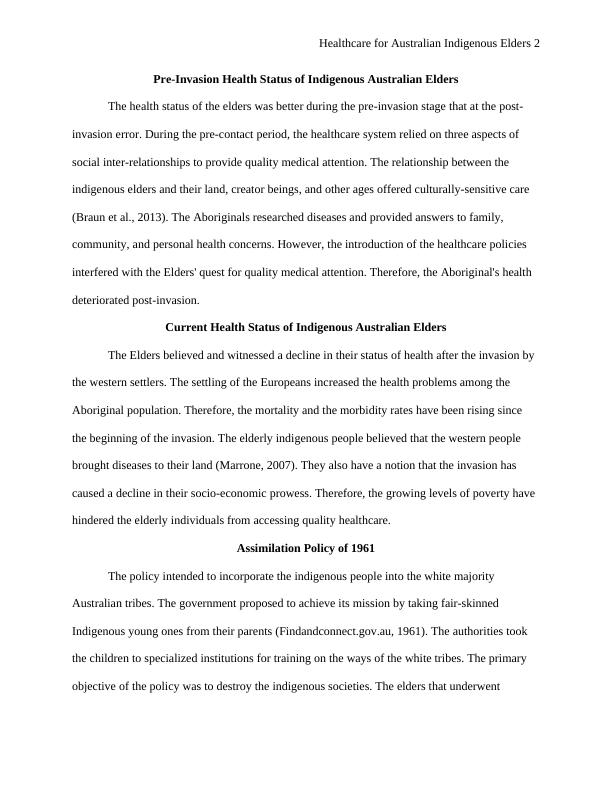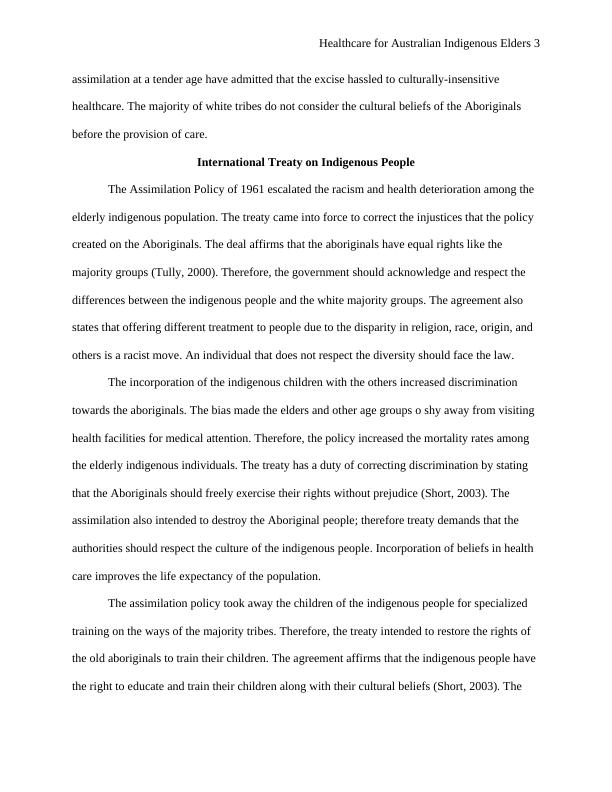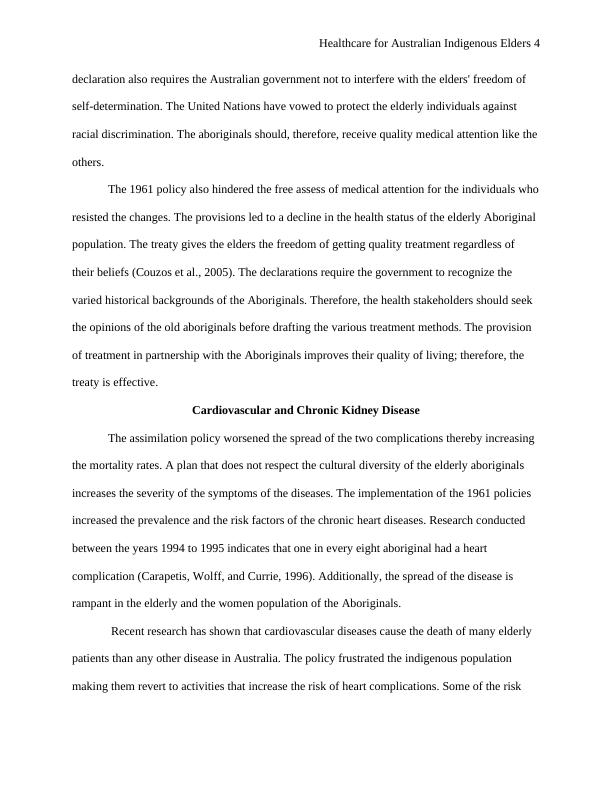Healthcare for Australian Indigenous Elders
Added on 2023-06-03
12 Pages3044 Words359 Views
Healthcare for Australian Indigenous Elders 1
HEALTHCARE FOR AUSTRALIAN INDIGENOUS ELDERS
By [Name]
Course
Professor’s Name
Institution
Location of Institution
Date
HEALTHCARE FOR AUSTRALIAN INDIGENOUS ELDERS
By [Name]
Course
Professor’s Name
Institution
Location of Institution
Date

Healthcare for Australian Indigenous Elders 2
Pre-Invasion Health Status of Indigenous Australian Elders
The health status of the elders was better during the pre-invasion stage that at the post-
invasion error. During the pre-contact period, the healthcare system relied on three aspects of
social inter-relationships to provide quality medical attention. The relationship between the
indigenous elders and their land, creator beings, and other ages offered culturally-sensitive care
(Braun et al., 2013). The Aboriginals researched diseases and provided answers to family,
community, and personal health concerns. However, the introduction of the healthcare policies
interfered with the Elders' quest for quality medical attention. Therefore, the Aboriginal's health
deteriorated post-invasion.
Current Health Status of Indigenous Australian Elders
The Elders believed and witnessed a decline in their status of health after the invasion by
the western settlers. The settling of the Europeans increased the health problems among the
Aboriginal population. Therefore, the mortality and the morbidity rates have been rising since
the beginning of the invasion. The elderly indigenous people believed that the western people
brought diseases to their land (Marrone, 2007). They also have a notion that the invasion has
caused a decline in their socio-economic prowess. Therefore, the growing levels of poverty have
hindered the elderly individuals from accessing quality healthcare.
Assimilation Policy of 1961
The policy intended to incorporate the indigenous people into the white majority
Australian tribes. The government proposed to achieve its mission by taking fair-skinned
Indigenous young ones from their parents (Findandconnect.gov.au, 1961). The authorities took
the children to specialized institutions for training on the ways of the white tribes. The primary
objective of the policy was to destroy the indigenous societies. The elders that underwent
Pre-Invasion Health Status of Indigenous Australian Elders
The health status of the elders was better during the pre-invasion stage that at the post-
invasion error. During the pre-contact period, the healthcare system relied on three aspects of
social inter-relationships to provide quality medical attention. The relationship between the
indigenous elders and their land, creator beings, and other ages offered culturally-sensitive care
(Braun et al., 2013). The Aboriginals researched diseases and provided answers to family,
community, and personal health concerns. However, the introduction of the healthcare policies
interfered with the Elders' quest for quality medical attention. Therefore, the Aboriginal's health
deteriorated post-invasion.
Current Health Status of Indigenous Australian Elders
The Elders believed and witnessed a decline in their status of health after the invasion by
the western settlers. The settling of the Europeans increased the health problems among the
Aboriginal population. Therefore, the mortality and the morbidity rates have been rising since
the beginning of the invasion. The elderly indigenous people believed that the western people
brought diseases to their land (Marrone, 2007). They also have a notion that the invasion has
caused a decline in their socio-economic prowess. Therefore, the growing levels of poverty have
hindered the elderly individuals from accessing quality healthcare.
Assimilation Policy of 1961
The policy intended to incorporate the indigenous people into the white majority
Australian tribes. The government proposed to achieve its mission by taking fair-skinned
Indigenous young ones from their parents (Findandconnect.gov.au, 1961). The authorities took
the children to specialized institutions for training on the ways of the white tribes. The primary
objective of the policy was to destroy the indigenous societies. The elders that underwent

Healthcare for Australian Indigenous Elders 3
assimilation at a tender age have admitted that the excise hassled to culturally-insensitive
healthcare. The majority of white tribes do not consider the cultural beliefs of the Aboriginals
before the provision of care.
International Treaty on Indigenous People
The Assimilation Policy of 1961 escalated the racism and health deterioration among the
elderly indigenous population. The treaty came into force to correct the injustices that the policy
created on the Aboriginals. The deal affirms that the aboriginals have equal rights like the
majority groups (Tully, 2000). Therefore, the government should acknowledge and respect the
differences between the indigenous people and the white majority groups. The agreement also
states that offering different treatment to people due to the disparity in religion, race, origin, and
others is a racist move. An individual that does not respect the diversity should face the law.
The incorporation of the indigenous children with the others increased discrimination
towards the aboriginals. The bias made the elders and other age groups o shy away from visiting
health facilities for medical attention. Therefore, the policy increased the mortality rates among
the elderly indigenous individuals. The treaty has a duty of correcting discrimination by stating
that the Aboriginals should freely exercise their rights without prejudice (Short, 2003). The
assimilation also intended to destroy the Aboriginal people; therefore treaty demands that the
authorities should respect the culture of the indigenous people. Incorporation of beliefs in health
care improves the life expectancy of the population.
The assimilation policy took away the children of the indigenous people for specialized
training on the ways of the majority tribes. Therefore, the treaty intended to restore the rights of
the old aboriginals to train their children. The agreement affirms that the indigenous people have
the right to educate and train their children along with their cultural beliefs (Short, 2003). The
assimilation at a tender age have admitted that the excise hassled to culturally-insensitive
healthcare. The majority of white tribes do not consider the cultural beliefs of the Aboriginals
before the provision of care.
International Treaty on Indigenous People
The Assimilation Policy of 1961 escalated the racism and health deterioration among the
elderly indigenous population. The treaty came into force to correct the injustices that the policy
created on the Aboriginals. The deal affirms that the aboriginals have equal rights like the
majority groups (Tully, 2000). Therefore, the government should acknowledge and respect the
differences between the indigenous people and the white majority groups. The agreement also
states that offering different treatment to people due to the disparity in religion, race, origin, and
others is a racist move. An individual that does not respect the diversity should face the law.
The incorporation of the indigenous children with the others increased discrimination
towards the aboriginals. The bias made the elders and other age groups o shy away from visiting
health facilities for medical attention. Therefore, the policy increased the mortality rates among
the elderly indigenous individuals. The treaty has a duty of correcting discrimination by stating
that the Aboriginals should freely exercise their rights without prejudice (Short, 2003). The
assimilation also intended to destroy the Aboriginal people; therefore treaty demands that the
authorities should respect the culture of the indigenous people. Incorporation of beliefs in health
care improves the life expectancy of the population.
The assimilation policy took away the children of the indigenous people for specialized
training on the ways of the majority tribes. Therefore, the treaty intended to restore the rights of
the old aboriginals to train their children. The agreement affirms that the indigenous people have
the right to educate and train their children along with their cultural beliefs (Short, 2003). The

Healthcare for Australian Indigenous Elders 4
declaration also requires the Australian government not to interfere with the elders' freedom of
self-determination. The United Nations have vowed to protect the elderly individuals against
racial discrimination. The aboriginals should, therefore, receive quality medical attention like the
others.
The 1961 policy also hindered the free assess of medical attention for the individuals who
resisted the changes. The provisions led to a decline in the health status of the elderly Aboriginal
population. The treaty gives the elders the freedom of getting quality treatment regardless of
their beliefs (Couzos et al., 2005). The declarations require the government to recognize the
varied historical backgrounds of the Aboriginals. Therefore, the health stakeholders should seek
the opinions of the old aboriginals before drafting the various treatment methods. The provision
of treatment in partnership with the Aboriginals improves their quality of living; therefore, the
treaty is effective.
Cardiovascular and Chronic Kidney Disease
The assimilation policy worsened the spread of the two complications thereby increasing
the mortality rates. A plan that does not respect the cultural diversity of the elderly aboriginals
increases the severity of the symptoms of the diseases. The implementation of the 1961 policies
increased the prevalence and the risk factors of the chronic heart diseases. Research conducted
between the years 1994 to 1995 indicates that one in every eight aboriginal had a heart
complication (Carapetis, Wolff, and Currie, 1996). Additionally, the spread of the disease is
rampant in the elderly and the women population of the Aboriginals.
Recent research has shown that cardiovascular diseases cause the death of many elderly
patients than any other disease in Australia. The policy frustrated the indigenous population
making them revert to activities that increase the risk of heart complications. Some of the risk
declaration also requires the Australian government not to interfere with the elders' freedom of
self-determination. The United Nations have vowed to protect the elderly individuals against
racial discrimination. The aboriginals should, therefore, receive quality medical attention like the
others.
The 1961 policy also hindered the free assess of medical attention for the individuals who
resisted the changes. The provisions led to a decline in the health status of the elderly Aboriginal
population. The treaty gives the elders the freedom of getting quality treatment regardless of
their beliefs (Couzos et al., 2005). The declarations require the government to recognize the
varied historical backgrounds of the Aboriginals. Therefore, the health stakeholders should seek
the opinions of the old aboriginals before drafting the various treatment methods. The provision
of treatment in partnership with the Aboriginals improves their quality of living; therefore, the
treaty is effective.
Cardiovascular and Chronic Kidney Disease
The assimilation policy worsened the spread of the two complications thereby increasing
the mortality rates. A plan that does not respect the cultural diversity of the elderly aboriginals
increases the severity of the symptoms of the diseases. The implementation of the 1961 policies
increased the prevalence and the risk factors of the chronic heart diseases. Research conducted
between the years 1994 to 1995 indicates that one in every eight aboriginal had a heart
complication (Carapetis, Wolff, and Currie, 1996). Additionally, the spread of the disease is
rampant in the elderly and the women population of the Aboriginals.
Recent research has shown that cardiovascular diseases cause the death of many elderly
patients than any other disease in Australia. The policy frustrated the indigenous population
making them revert to activities that increase the risk of heart complications. Some of the risk

End of preview
Want to access all the pages? Upload your documents or become a member.
Related Documents
Aboriginal Healthlg...
|11
|2994
|260
Health Care of Aboriginals and Torres Strait Islanderslg...
|12
|3195
|7
Aboriginal and Torres Strait Island Culture PDFlg...
|11
|3107
|207
Teaching and Learning in Aboriginal Education - SPlg...
|13
|3617
|445
Australian Government Healthcare Systemlg...
|12
|3069
|15
Policy of Assimilation 1961: Impact on Health Outcomes of Australian Indigenous Young Peopleslg...
|13
|3460
|255
